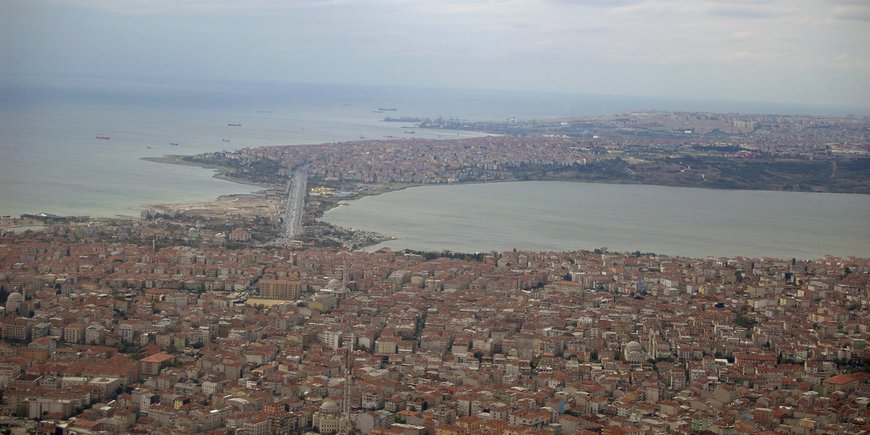In a paper published in the journal Seismological Research Letters, a group of the world's leading earthquake researchers has proposed the construction of "key observatories" near geological fault zones on land and on the seabed. In this way, the researchers want to get closer to the long-term goal of being able to predict earthquakes. So far, this has not been possible. In an interview, GFZ seismologist Marco Bohnhoff explains the motivation behind the initiative to build the next generation of large earthquake observatories worldwide.
Together with your colleagues you propose implementing a large earthquake research infrastructure comparable to a particle accelerator, a space telescope or a Mars mission. Aren't there already enough earthquake observatories around the world?
There are indeed already different types of earthquake observatories, for example national, regional and local seismometer networks. These are also internationally connected and primarily serve to monitor seismicity at different spatial scales. They also provide important data for research. On the other hand, there are a number of so-called Near-Fault Observatories (NFO). "Fault" here stands for geological plate boundary where quakes preferentially occur. These NFOs are located at a few selected sites, where they monitor specific areas of high seismic hazard with higher station density and partly in boreholes under low-noise conditions. Our initiative aims at developing and implementing the next generation of NFOs at key locations.
Why do we need such observatories?
A single strong earthquake can kill tens of thousands of people, cause infrastructure damage of hundreds of billions of euros, and generates highly noticeable secondary effects through internationalization, for example on financial markets. The social relevance is immense. We therefore want to develop a new generation of such NFOs that we can then use to specifically monitor earthquake hotspots with unprecedented accuracy. This would serve our goal of ultimately understanding the processes deep below our feet and being able to forecast earthquakes and quantify their effects.
Your concept, which you present in the journal "Seismological Research Letters," envisages key observatories distributed around the world. Which locations exactly do you have in mind, and why those in particular?
We have specific sites in mind, all of which are located at seismological hotspots, but in different tectonic environments. Our focus is on "transform faults," where the earth's plates move past each other and get locked due to friction on the faults. Energy then accumulates and is instantaneously released in –in part- large earthquakes. These transform faults are mostly on land and often run directly through or near mega-cities forming a big thread. Specifically, we have locations in mind on the North Anatolian Fault in Turkey with Istanbul as a mega-city and along the San Andreas Fault in California passing through the San Francisco and Los Angeles urban areas. We also address submarine "Oceanic Transform Faults", for example in the Red Sea and off Mexico.
Where exactly, and especially at what time, an earthquake occurs is determined by chance, after all. You talk about getting closer to the goal of earthquake prediction. Isn't that actually impossible?
The occurrence of earthquakes has nothing to do with chance. We just don't know enough about the complicated tectonic processes that occur many kilometers deep beneath our feet. We can simulate these processes on the computer and generate small tiny earthquakes in laboratory experiments, deforming rock samples under controlled conditions. But there is a huge difference between a piece of rock that breaks in the lab and a tens of kilometers long fault that ruptures inside earth's crust - we call this an observational gap linking the lab to the real processes in the earth. This is exactly where we come in: We want to finally close this gap in order to get one, maybe even THE decisive step closer to the long-term goal of earthquake prediction.
In your opinion, what would be the first steps towards earthquake prediction?
An earthquake does not occur out of nowhere, but starts where the energy accumulated by the tectonic loading process exceeds the rock strength. Then the fault starts breaking and grows into a mega-earthquake – or not. Theoretically, such processes can be simulated, but practically it is not yet possible to understand them well enough. The new data to be observed from our proposed key observatories would feed computer models and enable very specific laboratory experiments. A feedback loop that would take us further, but only on the basis of improved measurements where the earthquakes occur, i.e. at tectonic plate boundaries in nature.
Do you have a rough idea of the costs?
We estimate that the cost of installing up to ten such observatories will be between several hundred million and one billion euros. This is a large amount, but it is only a fraction of the economic damage caused by a single strong earthquake in an urban area. An improved database and a better understanding of the processes involved can save many lives and reduce the immense sorrow caused by earthquakes. It is not a question of if, but only when such earthquakes will occur. Mankind is not sufficiently prepared for them.
Where do you think we should start and how do you envisage implementation?
The next step will be to compile a steering group of ten top experts from around the world, which is already underway. Together with this group, we will then develop a plan for funding, planning, and implementation. We have the necessary technology at hand, we know what needs to be done, but we need the broad understanding of decision-makers in politics about the necessity of this project in order to realize it. After all, this is about securing livelihood.
You also talk about observatories for the oceanic crust. What do you mean by that: a building on the ocean floor?
Yes, observatories with monitoring devices would have to be built on the Seafloor along Oceanic Transform Faults. There, the physical processes that lead to earthquakes are the same as on land. Consequently, we can correlate findings from beneath the Sea with those on land. Logistically, such submarine observatories are much more difficult to implement. But there we can then conduct experiments on the ocean floor far away from megacities. The goal is to trigger earthquakes of medium magnitude in a controlled manner and to monitor them in all aspects and in great detail. We then want to transfer what we learn there to scenarios on land, where we cannot conduct such experiments, and use it specifically for improved earthquake risk mitigation. This relates to earthquake early warning and forecasting concepts, and then hopefully predictability at some point.
If you look back over the last two or three decades: What have been the biggest advances there?
In the past, the decisive progress was made in experiments in the laboratory on rock samples under controlled boundary conditions with the option to reproduce, and in computer simulations. Now the laboratory experiments have to be transferred to nature, so to speak, and scaled up to the Earth plate scale. We want to calibrate our models using real processes in the Earth's crust. That's why we launch our initiative now! Furthermore, we also want to deploy new monitoring capabilities. Such attempts in Japan in the past led directly to the discovery of tremor, slow slip events, very low frequency earthquakes, that were previously unknown, and that we’re still figuring out as well as their relationship to ordinary earthquakes. That’s what is needed to decipher the earthquake puzzle.
Original publication:
Yehuda Ben‐Zion, Gregory C. Beroza, Marco Bohnhoff, Alice‐Agnes Gabriel, Paul Martin Mai; A Grand Challenge International Infrastructure for Earthquake Science. Seismological Research Letters 2022;
doi: https://doi.org/10.1785/0220220266









![[Translate to English:] Torsten Sachs in front of a climate station on a field](/fileadmin/_processed_/3/9/csm__TorstenSachs_bearbeitet_GS_4a1365ef84.jpeg)

![[Translate to English:] left image flood at the Ahrtal: image from above, several houses are flooded; left image:: Heidi Kreibich;](/fileadmin/_processed_/4/4/csm_Bild2_9af0130e9f.png)



![[Translate to English:] Start der Vega Rakete](/fileadmin/_processed_/6/4/csm_20231201-kachel_Vega-VV23-launch_ESA-CNES-Arianespace_706716b68c.jpeg)









![[Translate to English:] Poster exhibition at the Brandenburg Hydrogen Day at the GFZ, some participants in the foreground](/fileadmin/_processed_/6/5/csm_Erster_Brandenburgischer_Wasserstofftag_GFZ_402fcec95e.jpeg)
![[Translate to English:] Group picture of the participants](/fileadmin/_processed_/9/4/csm_20231108_CAWa-Workshop-Tashkent_Gruppenbild_99ea779d8a.jpeg)

![[Translate to English:] [Translate to English:] Hörsaal](/fileadmin/_processed_/e/6/csm_H%C3%B6rsal_e21ac645fb.jpeg)


![[Translate to English:] The Delegations in the Historic Library on the Telegrafenberg. In the back there are from left to right, the Dutch Ambassador for Germany, Ronald van Roeden, the Dutch Minister for Education, Culture and Science, Robbert Dijkgraaf and the scientific director of the GFZ, Susanne Buiter.](/fileadmin/_processed_/d/b/csm_Kachel-2_9eba4b4212.jpeg)

